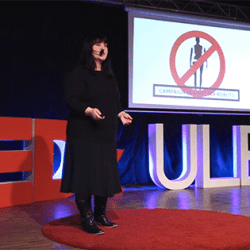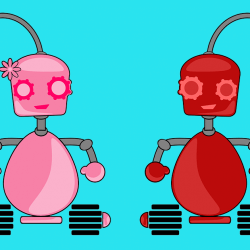Sexbot Perspectives: Robots and Artificial Humans Will Change Our Understanding of Attachment
How will we categorize sex with artificial lovers?

As part of our ongoing “Sexbot Perspectives” series, we’ve asked several experts this question: What is the potential or the possible pitfalls of developing sex robots? Our aim: To create dialogue and help shape the best possible future—one that will be deeply influenced by breakthroughs in artificial intelligence and robotics.
While many people are fascinated by sexual technologies, not everyone can say they have a doctorate degree in the field.
Dr. Trudy Barber stands out on both counts. For two decades she’s explored how people use technology for intimacy, earning a Ph.D. in Computer Fetishism and Sexual Futurology in the process. Barber also developed one of the first virtual reality sex environments as an undergrad student in 1992.
Currently, she’s a Senior Lecturer in Media Studies at the University of Portsmouth in England, where she specializes in topics such as cybersexualities, cyber/digital culture, robots, and emergent media—just to name a few. If that’s not endearing enough, Barber also makes and sells lino prints of happy robots.
According to Barber, sexualized machines will alter our views on attachment:
“We have our mobile phones. We have our PCs. We have our music, pictures, and other digital artefacts in The Cloud. We have the datafication of our interaction, and everyone knows where we are at any given point in time. Our attachment to such a plethora of digital artefacts is fluid, intense one moment and fleeting another, and our attention span is constantly bombarded by an information economy that seeks to know us in intimate microcosmic detail. Relationships are under pressure with this continuous attempt to remain part of “upgrade culture,” so it’s no wonder that we rush to find some form of attachment that will satiate our desires and make us feel safe within ourselves. Hence the rise of the concept and context of the Artificial Human (AH) and robot in popular culture which will renew and remind us of our attachment to a significant other, and the value we place on our living intimate relationships (if we are lucky enough to have one).
“Popular science fiction culture is always a good starting point for discussing robots—but now with such fast-paced technological developments, we are finally seeing the inception and production of early versions of AH and with it the usual explosion of “what-if” futurological questions so popular in Sci-Fi surrounding classic Frankenstein arguments that such sexual, emotional, and romantic attachments are against nature and demonstrate a perversion and deviation of social developments.
“Because of this, attachment to AH could be categorised separately from attachment to robots—depending on the function of the technology in question, as there are robots in industry, in the theatre of war, in retail, in entertainment—but defining the AH which confronts interpretations of the uncanny valley and looks human with facsimiles of our body parts as separate from the average robot—will influence our definition of emotional connectivity and attachment. This will amplify and clarify our connection to both technological and living things and will be another reading and interpretation of fetishism in relation to technology and robots, and challenge the inclusion of sexual fetishism as an argument against our intimate and romantic attachments to AH.
“We will need to redefine and re-contextualise categories of interaction between sex with robots and sex with Artificial Humans. Could having virtual cybersex via haptics through your computer or similar devices be classed as robot sex? Having physical intimacy with AH can be categorised as a synthesis of soft and hard tech and could be discussed as “synthetic sex.” “Robot sex” implies a cold shiny metallic sex, whereas “synthetic sex” changes the emphasis towards something a little more subtle and malleable. Attachment during a synthetic relationship would employ artificial intelligence on behalf of the AH. This has the potential to re-inforce attachment behaviour through learned responses by the AH and this could lay the ground for a basic synthesis of friendship. This will help an individual to develop their own psychological love map for their positive sexual life story, but in turn may make it awkward to accept real human sexual variation that may not necessarily re-inforce a sense of attachment.
“A consequence of this possible fast-paced and developing future is that our Saturdays will be spent polishing up our shiny sexy robots and doing their repairs in the garage, and in contrast—taking our Artificial Humans out for dinner.”
Image source: geralt
3 comments
Leave a reply
You must be logged in to post a comment.


















hi